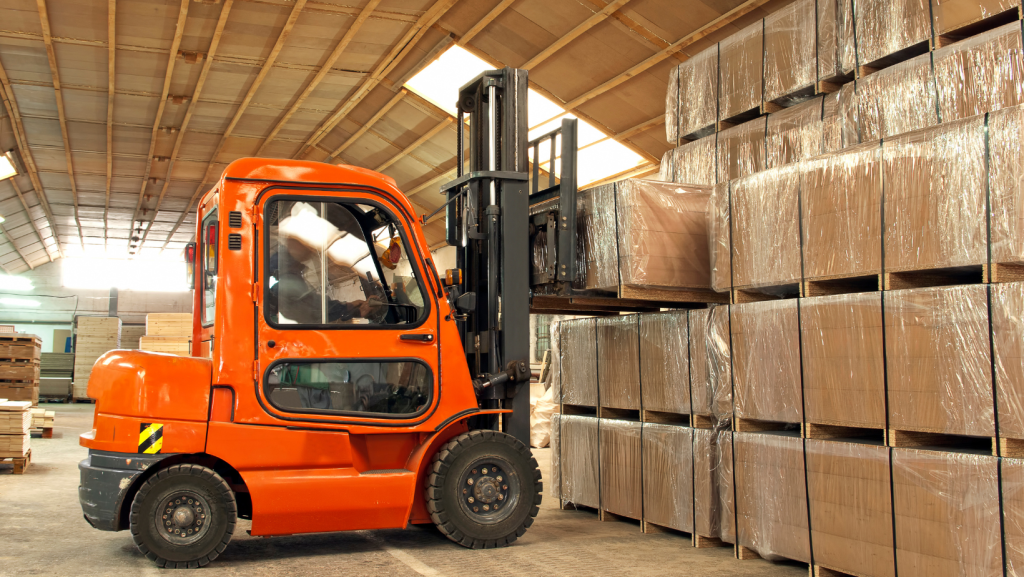

A forklift is indispensable for all warehouses and facilities where heavy loads must be transported between locations. Their efficiency is impressive; however, understanding their lift capacity is critical to ensure the operator’s and their surroundings’ safety. Whether you are a seasoned forklift operator or a complete novice, our comprehensive blog will detail the capabilities of your forklift and the safety aspects associated with your lift capacity.
Before determining your forklift’s capabilities, it is vital to understand how a forklift works. Essentially, the composition of a forklift means it acts similarly to a seesaw. If one side has more weight than the other, it can lead to tipping. These 3 main concepts define how forklifts are designed to prevent tip-overs:
The most important part of the concept is that the centre of gravity must fall in the stability triangle. This imaginary triangle exists between the centre of the rear axle and both front axle wheels. Once the centre of gravity lines up with the front axle after the load is applied, the forklift has reached its stability limit; beyond this limit, the forklift is at risk of tipping over.
The stability triangle is not only a triangle but a pyramid that incorporates the points between the axles horizontally but also vertically towards the top of the forklift. This stability pyramid concept is relevant to when a load is being lifted.
As a load is lifted, the combined centre of gravity moves towards the front axle and upwards. The centre of gravity cannot escape the confines of the pyramid, and therefore, operators will struggle to lift a heavy load at height compared to when the weight is closer to the ground. This emphasises the importance of carrying a load close to the ground to maintain the centre of gravity and ultimately reduce the danger of the forklift tipping over.
Forklift lift capacity is determined by the type of forklift that you operate. Lift capacity is the measurement of how much weight a forklift can carry, ranging from 3000lb to 50000lb. A safe load capacity should be calculated to ensure a safe operation during a forklift lift, especially when you have an oversized load.
Firstly, you should learn the standard load centre of your forklift. For example, if we assume that a forklift has a 24-inch load centre and a 3000lb capacity, but we need to handle a load with a load centre of 30 inches, a safe load capacity for this forklift would be less than 3000lb. OSHA states that “only loads within the rated capacity of a truck shall be handled”; it is therefore essential to never exceed the lifting capacity of your forklift.
To calculate the safe load capacity, take the standard load centre and divide it by the actual load centre, then multiply the figure by the rated capacity to retrieve the answer:
24 inches / 30 inches X 3000lb = 2400lb
The figure 2400lb is the approximate safe load capacity for a load centre of 30 inches.
Several factors can affect how much a forklift can carry. An operator should familiarise themselves with everything that can influence the lift capacity of their forklift to prevent any accidents from occurring.
The height at which a forklift will carry its load affects its maximum lift capacity. Lift height decreases as load capacity and load centre increase. Higher loads tend to be less stable, so it is recommended that operators drive their forklifts with the load as close to the ground as possible.
A newer, regularly serviced, and maintained forklift will have an increased lift capacity compared to an older fork with worn tyres and forks. The amount of wear and tear depends on the weight of the loads handled. A forklift loses 20% of its lifting capacity with every 10% of erosion of the fork’s surface. Forks should be replaced when necessary to maintain the maximum load capacity level.
Adding any attachment to a forklift will reduce the lifting capacity as it adds weight, extending the load centre. The distance in which the attachment extends the load centre forward is called the effective thickness; in turn, this causes the load moment to increase, subsequently decreasing the lifting capacity.
When considering a load with a 24-inch load centre, this is only applicable when a load is evenly distributed. The centre of gravity for an unevenly distributed load will either move forward or side-to-side. Due to this, the lifting capacity and stability of the load on the forklift decrease. In this case, operators should keep the load close to the ground during transportation.
Tyre types, widths, and sizes can influence the lifting capacity of a forklift. Cushion tyres can sustain a higher lifting capacity longer than pneumatic tyres. Dual tyre configurations and tyres with wider treads will increase a forklift’s overall lifting capacity by boosting stability. Tyres should be changed once worn to reduce any lifting faults.
By overloading your forklift, you increase the risk of accidents and injuries. A forklift with an overly heavy load will likely tip over if the centre of gravity is off. Tip-overs are the leading cause of forklift casualties each year.
A forklift licence does not exist. However, operators must have a UK driving licence and a certificate showcasing they have received appropriate training to operate a forklift safely and effectively.
To calculate the lifting capacity if you have a higher load centre than standard, you can find the rated lifting capacity of your forklift on its data plate.
Learn the ins and outs of operating a forklift with our wide range of training courses. HL Training Services delivers accredited in-centre and onsite training nationwide for forklift operators and instructors. Our training courses equip you with the expertise to operate a forklift safely and effectively. We have extensive experience in providing forklift training. Whether you are a novice or an experienced forklift operator, our team can offer training to suit your needs. Contact our knowledgeable team to learn more about our services; we will gladly assist.

HL Training Services is a trading name of Sheephouse Ltd.
Company no 4095134
The company is registered in England.
Directors: V J Hueston, J B Hueston & S A Richardson
Forklift Training Centre
HL Training Services,
4A Barton Hill Trading Estate
Herapath Street
Barton Hill
Bristol
BS5 9RD
© 2025 All Rights Reserved.